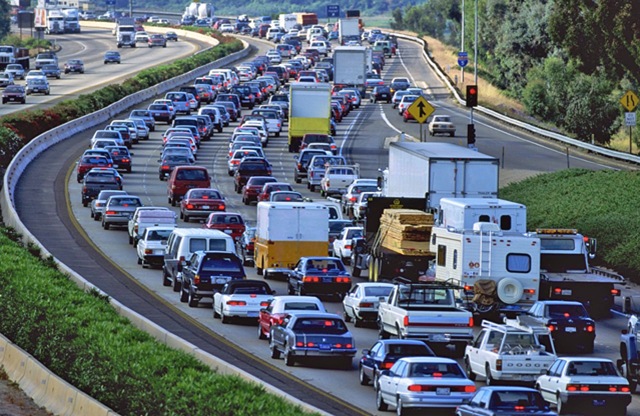A Socialist Rant on Transportation
If you're new here, you may want to subscribe. Thanks for visiting!
 Transportation systems and investments shape entire communities, and have a dramatic impact on overall public health. Since the 1950’s, America has fallen in love with the private automobile, and developed a sense of entitlement to instant, personal transportation. Along with this, the creation of suburbs has caused communities to be located away from town centers and public transportation, forcing communities to be entirely auto-dependent for transport and access. It creates a vicious cycle of funneling more and more money into roads and trying to ease congestion, then fueling more auto-oriented land development, and in turn demand for more roads, which marginalizes non-driving populations both economically and socially.
Transportation systems and investments shape entire communities, and have a dramatic impact on overall public health. Since the 1950’s, America has fallen in love with the private automobile, and developed a sense of entitlement to instant, personal transportation. Along with this, the creation of suburbs has caused communities to be located away from town centers and public transportation, forcing communities to be entirely auto-dependent for transport and access. It creates a vicious cycle of funneling more and more money into roads and trying to ease congestion, then fueling more auto-oriented land development, and in turn demand for more roads, which marginalizes non-driving populations both economically and socially.
The need for a shift in transportation policy is being driven by a variety of factors: near-crippling congestion in many metropolitan areas, renewed interest in city living and desire for shorter commutes, demographic shifts, which includes the increasing number of people over 65 and immigrants, two groups less likely to drive or own cars, the enduring poverty in inner-city and rural communities, the growing understanding of connections among health, the built environment, and transportation plans; and the increasing frustration among residents and advocates about the limited accountability and inequitable transportation decision-making, which quite frankly vastly over represent suburban and white male interests.
Many health areas are impacted by transportation policy, including physical activity, general health, air pollution, traffic safety, and household expenses and equity. Socially, much of the burden of disease and premature death is shouldered by vulnerable populations, including the elderly, children, the disabled, and underserved minorities who lack access to safe recreational areas, high-quality education, healthy food, medical care, and gainful employment, among other things. Nearly one-third of the U.S. population is transportation disadvantaged.
Obesity is the nation’s fastest rising health problem – 16 percent of children are obese*, and an additional 12 million kids are overweight, with overweight children more likely to become obese adults. Obesity and inactivity lead to other preventable chronic conditions such as high blood pressure, heart disease, osteoarthritis, cancer, stroke, and diabetes. Mental health is also affected when people are continually stressed by traffic, public transportation delays, less time with family and friends, and long commutes.
Pollution is another major factor. An estimated 35 million people live within 300 feet of a major roadway, and are at higher risk of pollution-related illnesses. Communities near heavily used highways have a proven increased incidence of lung cancer, asthma, and other respiratory illnesses. Furthermore, carbon dioxide is a greenhouse gas and the biggest human activity-related contributor to global climate change. The U.S. transportation sector accounts for 10% of the energy-producing greenhouse gas emissions worldwide. If left unchecked, these emissions could increase to 80% above current levels by 2060.
In terms of road safety, traffic fatalities are more likely to kill or disable Americans at a fairly young age – traffic accidents were the leading cause of death for people ages 5-34 in the U.S. in 2008, and the leading cause of injury-related death among all ages. For the past two decades, there has been an average of 43,000 traffic fatalities annually, and another 2.5 million annual injuries. The estimated costs of injury and property damage are approximately $164 billion per year. The number of drivers and time spent on the road is ever increasing, driving up the likelihood of accidents. Additionally, in underinvested neighborhoods, poorly designed streets, neglected road maintenance, inadequate lighting, limited sidewalks, and minimal traffic enforcement place residents at higher risk of injury. It is also a concern for elders, the fastest-growing segment of the population, who experience declines in their ability to drive safely as they age, and are also more likely to experience pedestrian injuries due to their slowing mobility.
The health of the general American population is at risk through poor community development planning and lack of attention to how we build our community supports. The combined impact of poor community design and a rising rate of preventable disease proves that transportation policy has a great impact on the overall health of the community, and must be a call to improve our health as we redesign our communities for the future.
* All statistics verified by the American Public Health Association.

![[del.icio.us]](../wp-content/plugins/bookmarkify/delicious.png)
![[Digg]](../wp-content/plugins/bookmarkify/digg.png)
![[Facebook]](../wp-content/plugins/bookmarkify/facebook.png)
![[Google]](../wp-content/plugins/bookmarkify/google.png)
![[Reddit]](../wp-content/plugins/bookmarkify/reddit.png)
![[Technorati]](../wp-content/plugins/bookmarkify/technorati.png)
![[Twitter]](../wp-content/plugins/bookmarkify/twitter.png)
![[Email]](../wp-content/plugins/bookmarkify/email.png)


